(Hanoi, 7th) The American financial website 'ainvest.com' recently published an article stating that despite multiple challenges facing the global economy, Vietnam has stood out with its remarkable economic performance, demonstrating strong resilience under pressure.
The article points out that in the second quarter of 2025, Vietnam's gross domestic product (GDP) grew by 7.96% year-on-year, making it one of the fastest-growing economies in Southeast Asia. Although the inflation rate during the same period was higher than the 3.01% in the first quarter, it remained within the government’s target range of 4.5%, indicating that overall price levels are still under control.
Analysts believe that the Vietnamese government’s prudent monetary policy has successfully avoided an inflation crisis, and the combination of a stable inflation environment with strong growth momentum creates a double advantage to attract long-term investors.
Behind the economic growth, the contributions of the industrial manufacturing and service sectors are especially notable. Data shows that in the second quarter, the industrial manufacturing sector grew by 10.3%, and the service sector grew by 8.14%, both powerfully driving the overall economic surge.
Meanwhile, foreign investor confidence has also rebounded significantly. In the first half of 2025, Vietnam attracted US$21.5 billion in committed foreign direct investment (FDI), a year-on-year increase of 32.6%. Retail sales also rose by 9.3%, reflecting a recovery in tourism and improving household consumption capacity.
The website’s analysis states that Vietnam is steadily advancing toward digital services and adopting consumption models that comply with environmental, social, and governance (ESG) standards, in order to enhance the sustainability and appeal of the overall economy.
However, the article also notes that potential risks remain, including global market demand fluctuations—especially the profound impact of major economies such as the United States and China on Vietnam’s exports—as well as uncertainties in geopolitics that could bring new inflationary pressures.
Nevertheless, the Vietnamese government’s response capability is seen as sufficient and effective. Measures ranging from promoting administrative reform to accelerate project approvals, implementing fiscal policies to strengthen infrastructure investments, to merging the country’s 63 provincial-level units into 34 to improve governance efficiency—all reflect the government’s determination and action in facing challenges.
The article concludes that Vietnam’s performance in the second quarter of 2025—in terms of GDP growth, inflation control, and foreign capital inflows—all showcase the resilience and potential of its economy. With a young labor force, rapid digitalization, and ongoing industrial modernization, Vietnam is gradually becoming a new global hotspot for strategic investment.
